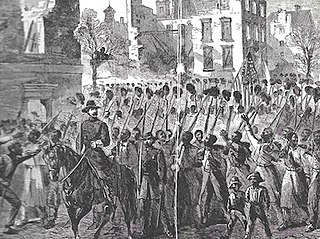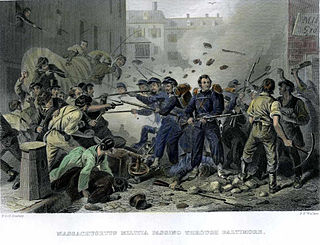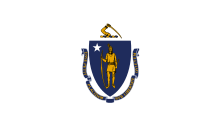
John Milton Deane was an American Civil War Medal of Honor recipient and a major in the United States Army.
The 3rd Massachusetts Volunteer Heavy Artillery Regiment was a unit that served in the Union Army during the American Civil War. It was organized from already mustered unattached companies of heavy artillery raised for the defenses of the Massachusetts coast.

The 51st Regiment Massachusetts Volunteer Infantry was a regiment of infantry that served in the Union Army during the American Civil War. The regiment was assigned to Major General John G. Foster's Department of North Carolina, later designated as the XVIII Corps. While based in New Bern, North Carolina, the 51st Massachusetts took part in several expeditions involving numerous units from Foster's command and were engaged in the Battle of Kinston, the Battle of White Hall and the Battle of Goldsborough Bridge, among other engagements.

The 7th Regiment Massachusetts Volunteer Infantry was an infantry regiment in the Union army during the American Civil War. It was formed on June 15, 1861, in Taunton. Its original commander was Colonel Darius N. Couch who would eventually be promoted to command the II Corps of the Army of the Potomac and, after that, the Department of the Susquehanna.

The 29th Regiment Massachusetts Volunteer Infantry was an infantry regiment in the Union army of the United States during the American Civil War. The regiment was organized in December 1861 when three new companies were attached to a battalion of seven Massachusetts companies that had been in active service since May 1861. These seven companies had been recruited to fill out the 3rd Massachusetts and 4th Massachusetts regiments and had signed on for three years of service. When the 3rd and 4th Massachusetts were mustered out in July 1861, the seven companies that had signed on for three years were grouped together to form a battalion known as the Massachusetts Battalion. Finally, in December 1861, three more companies were added to their roster to form a full regiment and the unit was designated the 29th Massachusetts.

The 55th Massachusetts Infantry Regiment was the sister regiment of the renowned Massachusetts 54th Volunteers during the latter half of the American Civil War, formed because of the overflow of volunteer enlistees to the 54th Massachusetts.
The 3rd Massachusetts Volunteer Cavalry Regiment was a cavalry regiment that served in the Union Army during the American Civil War. It was organized by consolidating the 41st Massachusetts Mounted Infantry and the 2nd Battalion Massachusetts Cavalry on June 17, 1863. The regiment served with the XIX Corps, Army of the Gulf during the Red River Campaign in 1864. Its heaviest combat during this campaign took place during the Battle of Sabine Crossroads.

The 3rd Massachusetts Volunteer Militia Regiment was a peacetime regiment of infantry that was activated for federal service in the Union Army for two separate tours during the American Civil War. The regiment consisted of companies from Plymouth and Bristol Counties.

The 5th Regiment Massachusetts Volunteer Militia was a peacetime infantry regiment that was activated for federal service in the Union army for three separate tours during the American Civil War. In the years immediately preceding the war and during its first term of service, the regiment consisted primarily of companies from Essex County as well as Boston and Charlestown.

The 6th Regiment Massachusetts Volunteer Militia was a peacetime infantry regiment that was activated for federal service in the Union army for three separate terms during the American Civil War (1861-1865). The regiment gained notoriety as the first unit in the Union Army to suffer fatal casualties in action during the Civil War in the Baltimore Riot and the first militia unit to arrive in Washington D.C., in response to President Abraham Lincoln's initial call for 75,000 troops. Private Luther C. Ladd of the 6th Massachusetts is often referred to as the first Union soldier killed in action during the war.

The 42nd Regiment Massachusetts Volunteer Infantry was a regiment of infantry that served two tours in the Union Army during the American Civil War. The unit was first formed in September 1862 in response to President Abraham Lincoln's call for 300,000 men to serve for nine months.

The 3rd Battalion Massachusetts Rifles was an infantry unit created at the start of the American Civil War and activated for federal service in the Union army for a term of ninety days. It consisted of three companies of prewar militia and one newly recruited company together organized under the command of Major Charles Devens. The term "rifles" was a designation frequently given to antebellum militia companies which trained in the use of rifled muskets—a relatively new innovation at the time—as opposed to smoothbore muskets. Only minor differences in training and tactics differentiated such units from a typical infantry company of the time. During the 1840s, "rifle" companies were often expected to train and serve as skirmishers in open order, however by the Civil War, United States army tactics manuals made no distinction between a company of "rifles" and a typical infantry company.

The 47th Massachusetts Infantry Regiment was a regiment of infantry that served in the Union Army during the American Civil War. It was one of the 18 Massachusetts regiments formed in response to President Abraham Lincoln's August 1862 call for 300,000 men to serve for nine months. The unit was known as the "Merchant's Guard Regiment" having been recruited primarily through the efforts of Boston merchant Lucius B. Marsh, who became the regiment's Colonel and commanding officer. The regiment's service was unusual in that it never saw combat as a full regiment. Two detached companies saw minor skirmishing without casualties. Instead of active combat duty, the regiment served guard and provost duty in various camps and fortifications in and about New Orleans, Louisiana.

The 48th Regiment Massachusetts Volunteer Infantry was a regiment of infantry that served in the Union Army during the American Civil War. It was one of the 18 Massachusetts regiments formed in response to President Abraham Lincoln's August 1862 call for 300,000 men to serve for nine months. It consisted of a combination of Essex County companies and Irish-American companies which caused some delay and friction during the unit's formation. The regiment was assigned to the Department of the Gulf and saw heavy combat during the Siege of Port Hudson.

The 49th Regiment Massachusetts Volunteer Infantry was a regiment of infantry that served in the Union Army during the American Civil War. It was one of the 18 Massachusetts regiments formed in response to President Abraham Lincoln's August 1862 call for 300,000 men to serve for nine months. The regiment was recruited in Berkshire County and rendezvoused for mustering in at Camp Briggs in Pittsfield, Massachusetts. William F. Bartlett, a veteran of the 20th Massachusetts was voted colonel in command of the regiment. The 49th Massachusetts was assigned to the Department of the Gulf and saw heavy combat during the Siege of Port Hudson.

The 50th Regiment Massachusetts Volunteer Infantry was a regiment of infantry that served in the Union Army during the American Civil War. It was one of the 18 Massachusetts regiments formed in response to President Abraham Lincoln's August 1862 call for 300,000 men to serve for nine months. The regiment was recruited in Essex County and rendezvoused for mustering in at Camp Edwin M. Stanton in Boxford, Massachusetts. The 50th Massachusetts was assigned to the Department of the Gulf under Major General Nathaniel P. Banks and shipped for Louisiana. The regiment saw combat during the Siege of Port Hudson.

The 1st Massachusetts Battery was a peacetime militia artillery battery that was activated for federal service in the Union army for two separate tours during the American Civil War. Prior to the war and during its first term of service, the unit was sometimes known as "Cook's Battery" after its commanding officer, Capt. Asa M. Cook. During its first term, the battery primarily served garrison duty in Baltimore, Maryland. Almost immediately after mustering out, the unit began preparing for a second term, this time volunteering to serve for three years. The battery was attached to the VI Corps of the Army of the Potomac during its second term and took part in some of the largest battles of the war including the Fredericksburg, Chancellorsville, Gettysburg, and Lieutenant General Ulysses S. Grant's Overland Campaign in the spring of 1864.

The 4th Massachusetts Battery was an artillery battery that served in the Union Army during the American Civil War. The unit was sometimes known as "Manning's Battery" after its commanding officer, Capt. Charles H. Manning. It was one of the Massachusetts regiments organized in response to President Abraham Lincoln's call on May 2, 1861 for volunteer troops to serve a term of three-years. The core of the unit was a peace-time militia company known as the Salem Light Artillery. The battery trained at Camp Chase in Lowell, Massachusetts. It was assigned to the Department of the Gulf under Major General Benjamin F. Butler and departed Boston by steamship on November 20.

The 5th Massachusetts Battery was an artillery battery that served in the Union army during the American Civil War. It was one of the Massachusetts regiments organized in response to President Abraham Lincoln's call on May 2, 1861 for volunteer troops to serve a term of three-years. The battery trained at Camp Shouler in Lynnfield, Massachusetts and Camp Massasoit in Readville, Massachusetts. It departed Boston by steamship on December 25, 1861.

The 7th Massachusetts Battery was an artillery battery that served in the Union Army during the American Civil War. The original core of the unit was a company of infantry known as the Richardson Light Guard. The company initially served provost duty at Fortress Monroe, was eventually trained in light artillery drill, and reorganized on March 17, 1862 as the 7th Massachusetts Battery.












